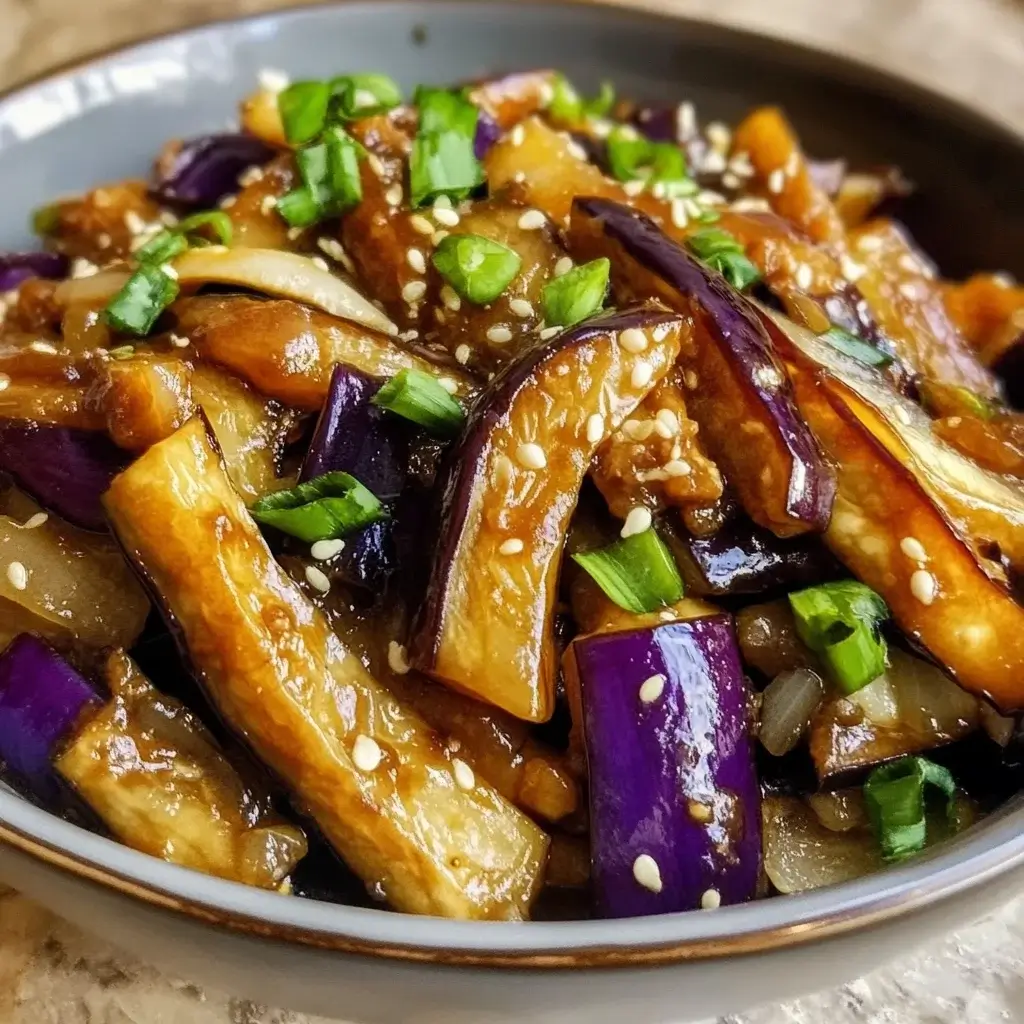Getting my family excited about vegetables can sometimes feel like a culinary challenge, especially when it comes to eggplant. Its unique texture can be polarizing! But let me tell you, this Savory Eggplant Stir Fry recipe completely changed the game in our household. The first time I made it, the aroma alone drew everyone to the kitchen. The eggplant, perfectly tender and almost creamy, soaked up the rich, savory, umami-packed sauce like a sponge. There was a subtle sweetness, a hint of tang, and that wonderful depth from garlic and ginger. Paired with fluffy rice, it was devoured. Even my most skeptical child asked for seconds, remarking on how “meaty” and flavorful the eggplant was. It wasn’t mushy or bitter, problems I’d sometimes encountered with other eggplant dishes. This stir-fry achieves that elusive perfect texture – slightly charred edges giving way to a meltingly soft interior, all coated in a glossy, irresistible sauce. It has since become a regular, much-requested star in our weeknight dinner rotation, proving that even seemingly tricky vegetables can become family favorites with the right approach. It’s quick, adaptable, and delivers restaurant-quality flavor right from your own wok or skillet.
Ingredients
Here’s what you’ll need to create this incredibly flavorful Savory Eggplant Stir Fry:
- Eggplant: 2 medium Chinese or Japanese eggplants (about 1-1.5 lbs total). These varieties are preferred for their thinner skin, fewer seeds, and tender texture, which readily absorbs the sauce without becoming bitter. Cut into bite-sized pieces (approx. 1-inch cubes or thick half-moons).
- Neutral Cooking Oil: 3-4 tablespoons (like vegetable, canola, grapeseed, or avocado oil). Needed for stir-frying the eggplant until tender and slightly browned. You might need slightly more depending on how much the eggplant absorbs.
- Garlic: 4-5 cloves, minced. Forms the aromatic base of the stir-fry, providing a pungent depth.
- Ginger: 1 tablespoon, freshly grated or minced. Adds a warm, zesty counterpoint to the garlic.
- Green Onions (Scallions): 3-4 stalks, thinly sliced. Separate the white/light green parts (for cooking) from the dark green parts (for garnish). Adds a mild oniony freshness.
- Sesame Oil: 1 teaspoon, toasted. Added at the end for its distinct nutty aroma and flavor; high heat can diminish its taste.
For the Savory Stir-Fry Sauce:
- Low-Sodium Soy Sauce: 1/4 cup. Provides the primary salty and umami base. Low-sodium allows for better control over the final saltiness. Use Tamari for a gluten-free option.
- Water or Vegetable Broth: 1/4 cup. Helps create volume for the sauce and prevents it from becoming too thick or salty. Broth adds a little extra flavor depth.
- Rice Vinegar: 1 tablespoon. Adds a crucial touch of acidity to balance the richness and saltiness. Unseasoned rice vinegar is preferred.
- Brown Sugar or Maple Syrup: 1 tablespoon (packed if using brown sugar). Provides a subtle sweetness to balance the savory and tangy elements. Adjust to your preference.
- Cornstarch: 1 tablespoon. The thickening agent that gives the sauce its glossy, coating consistency.
- Optional: Red Pepper Flakes: 1/4 – 1/2 teaspoon (or to taste). For those who enjoy a gentle background heat.
- Optional: Oyster Sauce (or Vegetarian Oyster Sauce): 1 tablespoon. Deepens the umami flavor significantly with a complex sweet-savory note. Use a mushroom-based vegetarian version if needed.
Instructions
Follow these steps carefully for a perfectly cooked Savory Eggplant Stir Fry:
- Prepare the Eggplant (Optional but Recommended Salting): Place the cut eggplant pieces in a colander set over a bowl or the sink. Sprinkle generously with about 1-2 teaspoons of salt and toss gently to coat. Let it sit for 20-30 minutes. This process draws out excess moisture and some bitterness, helping the eggplant brown better and absorb less oil, resulting in a creamier, less spongy texture. After salting, thoroughly rinse the eggplant under cold running water to remove the excess salt. Pat the pieces completely dry with paper towels or a clean kitchen towel. This drying step is crucial; wet eggplant will steam instead of fry and can cause oil to splatter dangerously.
- Mix the Sauce: While the eggplant is salting (or just before you start cooking if skipping the salting step), prepare the stir-fry sauce. In a small bowl, whisk together the low-sodium soy sauce, water or vegetable broth, rice vinegar, brown sugar (or maple syrup), cornstarch, optional red pepper flakes, and optional oyster sauce (or its vegetarian alternative). Ensure the cornstarch is fully dissolved to prevent lumps. Set the sauce aside.
- Prepare Aromatics and Scallions: Have your minced garlic, grated ginger, and sliced green onions (whites and greens separated) ready near the stove. Stir-frying moves quickly, so having everything prepped (‘mise en place’) is essential.
- Cook the Eggplant: Heat a large skillet or wok over medium-high heat. Once hot (a drop of water should evaporate instantly), add 2-3 tablespoons of the neutral cooking oil. Swirl to coat the bottom. Carefully add the dried eggplant pieces in a single layer, being careful not to overcrowd the pan (work in batches if necessary). Cook for about 8-10 minutes, turning occasionally, until the eggplant is tender, golden brown, and slightly collapsed. It should be soft enough to pierce easily with a fork but still hold its shape. Add the remaining tablespoon of oil during cooking if the pan looks dry, as eggplant tends to soak it up. Once cooked, remove the eggplant from the skillet/wok and set it aside on a plate.
- Sauté Aromatics: Reduce the heat slightly to medium. Add the remaining teaspoon or so of oil to the skillet if needed. Add the minced garlic, grated ginger, and the white/light green parts of the sliced green onions. Stir-fry for about 30-60 seconds until fragrant. Be careful not to burn the garlic, which can turn bitter.
- Combine and Sauce: Return the cooked eggplant to the skillet/wok with the aromatics. Give the prepared stir-fry sauce a quick whisk again (as the cornstarch might have settled) and pour it over the eggplant.
- Thicken the Sauce: Increase the heat back to medium-high. Stir gently and continuously, coating the eggplant evenly with the sauce. Cook for 1-2 minutes, or until the sauce bubbles and thickens to a glossy consistency that coats the back of a spoon. The heat activates the cornstarch, creating that luscious glaze.
- Finish and Serve: Turn off the heat. Stir in the toasted sesame oil and the reserved dark green parts of the green onions. Toss gently one last time to combine. Serve immediately for the best texture and flavor.
Nutrition Facts
- Servings: This recipe typically serves 2-3 people as a main course or 4 people as a side dish.
- Calories Per Serving (approximate): Roughly 250-350 calories per serving (assuming 3 servings), depending heavily on the amount of oil absorbed by the eggplant and any added ingredients.
- Fiber: Eggplant is a good source of dietary fiber, crucial for digestive health and helping you feel full. This dish provides a significant portion of your daily fiber needs.
- Sodium: While using low-sodium soy sauce helps, stir-fry sauces can be high in sodium. Be mindful of portion sizes if sodium intake is a concern. Using water instead of broth and omitting optional oyster sauce can reduce sodium further.
- Carbohydrates: Primarily from the eggplant, sugar/maple syrup in the sauce, and cornstarch. Provides energy.
- Vitamins & Minerals: Eggplant offers manganese, folate, potassium, and vitamins K and C. Garlic and ginger contribute additional antioxidants and beneficial compounds.
(Note: These are estimates. Actual nutritional values can vary based on specific ingredients, brands, oil absorption, and portion sizes.)
Preparation Time
- Total Time: Approximately 40-50 minutes.
- Prep Time: 25-35 minutes (includes the optional 20-30 minute salting time and chopping).
- Cook Time: 15-20 minutes.
- Short Description: This recipe involves some initial preparation, especially if salting the eggplant, but the active cooking process is relatively quick, typical of stir-fries. Having all ingredients prepped before starting to cook is key to a smooth process.
How to Serve
This Savory Eggplant Stir Fry is versatile and pairs beautifully with various accompaniments:
- With Rice:
- Serve hot over a bed of fluffy steamed Jasmine rice. The fragrant rice perfectly absorbs the savory sauce.
- Pair with brown rice for a nuttier flavor and added fiber.
- Coconut rice can add a subtle tropical sweetness that complements the dish surprisingly well.
- With Noodles:
- Toss with cooked udon noodles for a satisfying, chewy texture.
- Serve alongside simple ramen noodles (discard the seasoning packet) or soba noodles.
- Mix with thin rice noodles for a lighter pairing.
- As Part of a Larger Meal:
- Serve as a flavorful vegetarian/vegan main course.
- Offer it as a side dish alongside grilled chicken, fish, tofu, or other Asian-inspired dishes like Kung Pao Chicken or Sweet and Sour Pork.
- Include it in a multi-dish spread for family-style dining.
- With Other Grains:
- Serve over cooked quinoa for a protein and fiber boost.
- Try it with couscous for a different textural experience.
- Garnishes:
- Sprinkle with toasted sesame seeds for extra crunch and nutty flavor.
- Add a handful of chopped fresh cilantro for a burst of freshness.
- A drizzle of sriracha or chili garlic sauce for extra heat.
Additional Tips
Enhance your Savory Eggplant Stir Fry experience with these eight helpful tips:
- Choose the Right Eggplant: While Globe eggplants can work, Chinese or Japanese varieties are highly recommended. Their thinner skin is edible and less tough, their flesh is more tender and less bitter, and they contain fewer seeds. This leads to a creamier texture that better absorbs the delicious sauce. Look for firm eggplants with smooth, shiny skin and no soft spots or blemishes.
- Don’t Skip the Salting (If Time Allows): As mentioned in the instructions, salting the eggplant before cooking makes a noticeable difference. It draws out excess water, preventing the eggplant from becoming overly oily or steaming instead of frying. It also helps remove potential bitterness and results in a creamier final texture. Remember to rinse thoroughly and pat completely dry afterward. If you’re very short on time, you can skip this, but be prepared for the eggplant to potentially absorb more oil.
- Master High-Heat Cooking: Stir-frying relies on high heat to cook ingredients quickly while retaining texture and developing flavor (sometimes referred to as ‘wok hei’ or “breath of the wok”). Ensure your pan is properly preheated before adding the oil and eggplant. This helps sear the outside quickly, preventing sogginess. Maintain medium-high heat throughout most of the cooking process, adjusting as needed to prevent burning the garlic.
- Avoid Overcrowding the Pan: This is a cardinal rule of stir-frying. Adding too much eggplant (or any ingredient) to the pan at once lowers the temperature significantly. Instead of frying and browning, the eggplant will steam in its own moisture, leading to a mushy texture. Cook the eggplant in batches if your skillet or wok isn’t large enough to hold it in a single layer with some space between pieces.
- Control the Sauce Thickness: The cornstarch slurry is key to the sauce’s glossy texture. If your sauce seems too thin after adding it, let it bubble for another 30-60 seconds; the heat will continue to activate the cornstarch. If it becomes too thick, quickly stir in a tablespoon of water or broth at a time until it reaches your desired consistency. Remember the sauce will thicken slightly more as it cools.
- Customize with Add-Ins: This recipe is a fantastic base. Feel free to add other vegetables like sliced bell peppers (red or green), onions, broccoli florets, snow peas, or mushrooms. Add firmer vegetables earlier in the cooking process and quicker-cooking ones towards the end. You can also add protein like cubed firm or extra-firm tofu (press and pan-fry it separately first for best texture), cooked chicken, shrimp, or beef strips. Add cooked proteins back in with the eggplant just before adding the sauce.
- Prep Ahead for Speed: To make this a super-fast weeknight meal, do some prep work in advance. The sauce can be mixed and stored in an airtight container in the refrigerator for 2-3 days. Vegetables like garlic, ginger, and green onions can be chopped and stored separately. You can even cut the eggplant ahead of time, but store it submerged in acidulated water (water with a splash of vinegar or lemon juice) to prevent browning, then drain and dry thoroughly before use (salting might be less effective after prolonged soaking).
- Reheating Wisely: While best enjoyed fresh, leftovers can be stored in an airtight container in the refrigerator for up to 3 days. Eggplant texture can soften upon reheating. The best way to reheat is generally in a skillet or wok over medium heat with a tiny splash of water or oil to help loosen the sauce and prevent sticking. Microwaving is possible but may result in a softer, slightly less desirable texture. Avoid freezing this dish, as eggplant becomes very mushy and watery upon thawing.
FAQ Section
Here are answers to some frequently asked questions about making Savory Eggplant Stir Fry:
- Q: My eggplant sometimes tastes bitter. How can I avoid that?
- A: Bitterness in eggplant can stem from the variety used or its maturity. Choosing younger, smaller Chinese or Japanese eggplants generally helps, as they tend to be less bitter than larger Globe eggplants. The salting process (Tip #2) is also very effective at drawing out bitter compounds along with excess moisture. Rinsing well after salting is key to removing both the salt and the extracted bitter juices.
- Q: Why did my eggplant turn out soggy and oily?
- A: This usually happens for a few reasons: A) The cooking temperature was too low, causing the eggplant to absorb oil slowly like a sponge instead of searing. Ensure your pan is hot! B) You overcrowded the pan, leading to steaming instead of frying (Tip #4). C) You skipped the salting step, leaving too much moisture in the eggplant (Tip #2). D) You added wet eggplant to hot oil; ensure it’s patted thoroughly dry after rinsing (or if not salting).
- Q: Is this recipe vegan?
- A: This recipe can easily be made vegan. The primary ingredient to check is the optional oyster sauce, which is traditionally made from oysters. Simply omit it, or substitute it with a readily available vegetarian/vegan “oyster” sauce, which is typically made from mushrooms and provides a similar umami depth. All other base ingredients (eggplant, oil, aromatics, soy sauce, vinegar, sugar, cornstarch) are typically vegan, but always double-check labels if you have strict dietary needs.
- Q: Can I make this recipe gluten-free?
- A: Yes, making this gluten-free is straightforward. The main source of gluten is typically the soy sauce. Substitute it with an equal amount of gluten-free tamari or coconut aminos. Coconut aminos are slightly sweeter, so you might want to slightly reduce the added sugar/maple syrup. Also, ensure your cornstarch is certified gluten-free if Celiac disease is a concern, although cornstarch itself is naturally gluten-free. If using oyster sauce, check that your vegetarian alternative is also gluten-free.
- Q: How can I adjust the spice level?
- A: The recipe includes optional red pepper flakes for a mild background heat. To increase the spice, simply add more red pepper flakes to the sauce mixture. You could also add a chopped fresh chili (like a Thai chili or serrano, seeds removed for less heat) along with the garlic and ginger. For a different kind of heat, consider adding a teaspoon or two of sriracha, chili garlic sauce, or gochujang (Korean chili paste) to the sauce mixture. Start small and taste as you go. If you prefer no heat, just omit the red pepper flakes entirely.
- Q: Can I use regular Globe eggplant instead of Chinese/Japanese eggplant?
- A: Yes, you can use Globe eggplant, but there are a few considerations. Globe eggplants have thicker skin, which some people prefer to peel before cutting. They also tend to have more seeds and can sometimes be more bitter and absorb more oil. The salting step (Tip #2) becomes even more important with Globe eggplant. You might need to cook it slightly longer to ensure it becomes fully tender. The final texture might be slightly less creamy than with Asian varieties, but it will still be delicious. Cut it into slightly smaller cubes (around 3/4-inch) to help it cook evenly.
- Q: How should I store leftovers?
- A: Allow the stir-fry to cool completely, then transfer it to an airtight container. Store it in the refrigerator for up to 3 days. The texture of the eggplant may soften slightly upon storing and reheating, but the flavors will remain delicious.
- Q: Can I freeze Savory Eggplant Stir Fry?
- A: Freezing is generally not recommended for this dish. Eggplant has high water content, and the freezing and thawing process tends to rupture its cell walls, resulting in a very mushy, watery, and unpleasant texture once reheated. It’s best enjoyed fresh or refrigerated for a few days.

Savory Eggplant Stir Fry
Ingredients
Here’s what you’ll need to create this incredibly flavorful Savory Eggplant Stir Fry:
- Eggplant: 2 medium Chinese or Japanese eggplants (about 1-1.5 lbs total). These varieties are preferred for their thinner skin, fewer seeds, and tender texture, which readily absorbs the sauce without becoming bitter. Cut into bite-sized pieces (approx. 1-inch cubes or thick half-moons).
- Neutral Cooking Oil: 3-4 tablespoons (like vegetable, canola, grapeseed, or avocado oil). Needed for stir-frying the eggplant until tender and slightly browned. You might need slightly more depending on how much the eggplant absorbs.
- Garlic: 4-5 cloves, minced. Forms the aromatic base of the stir-fry, providing a pungent depth.
- Ginger: 1 tablespoon, freshly grated or minced. Adds a warm, zesty counterpoint to the garlic.
- Green Onions (Scallions): 3-4 stalks, thinly sliced. Separate the white/light green parts (for cooking) from the dark green parts (for garnish). Adds a mild oniony freshness.
- Sesame Oil: 1 teaspoon, toasted. Added at the end for its distinct nutty aroma and flavor; high heat can diminish its taste.
For the Savory Stir-Fry Sauce:
- Low-Sodium Soy Sauce: 1/4 cup. Provides the primary salty and umami base. Low-sodium allows for better control over the final saltiness. Use Tamari for a gluten-free option.
- Water or Vegetable Broth: 1/4 cup. Helps create volume for the sauce and prevents it from becoming too thick or salty. Broth adds a little extra flavor depth.
- Rice Vinegar: 1 tablespoon. Adds a crucial touch of acidity to balance the richness and saltiness. Unseasoned rice vinegar is preferred.
- Brown Sugar or Maple Syrup: 1 tablespoon (packed if using brown sugar). Provides a subtle sweetness to balance the savory and tangy elements. Adjust to your preference.
- Cornstarch: 1 tablespoon. The thickening agent that gives the sauce its glossy, coating consistency.
- Optional: Red Pepper Flakes: 1/4 – 1/2 teaspoon (or to taste). For those who enjoy a gentle background heat.
- Optional: Oyster Sauce (or Vegetarian Oyster Sauce): 1 tablespoon. Deepens the umami flavor significantly with a complex sweet-savory note. Use a mushroom-based vegetarian version if needed.
Instructions
Follow these steps carefully for a perfectly cooked Savory Eggplant Stir Fry:
- Prepare the Eggplant (Optional but Recommended Salting): Place the cut eggplant pieces in a colander set over a bowl or the sink. Sprinkle generously with about 1-2 teaspoons of salt and toss gently to coat. Let it sit for 20-30 minutes. This process draws out excess moisture and some bitterness, helping the eggplant brown better and absorb less oil, resulting in a creamier, less spongy texture. After salting, thoroughly rinse the eggplant under cold running water to remove the excess salt. Pat the pieces completely dry with paper towels or a clean kitchen towel. This drying step is crucial; wet eggplant will steam instead of fry and can cause oil to splatter dangerously.
- Mix the Sauce: While the eggplant is salting (or just before you start cooking if skipping the salting step), prepare the stir-fry sauce. In a small bowl, whisk together the low-sodium soy sauce, water or vegetable broth, rice vinegar, brown sugar (or maple syrup), cornstarch, optional red pepper flakes, and optional oyster sauce (or its vegetarian alternative). Ensure the cornstarch is fully dissolved to prevent lumps. Set the sauce aside.
- Prepare Aromatics and Scallions: Have your minced garlic, grated ginger, and sliced green onions (whites and greens separated) ready near the stove. Stir-frying moves quickly, so having everything prepped (‘mise en place’) is essential.
- Cook the Eggplant: Heat a large skillet or wok over medium-high heat. Once hot (a drop of water should evaporate instantly), add 2-3 tablespoons of the neutral cooking oil. Swirl to coat the bottom. Carefully add the dried eggplant pieces in a single layer, being careful not to overcrowd the pan (work in batches if necessary). Cook for about 8-10 minutes, turning occasionally, until the eggplant is tender, golden brown, and slightly collapsed. It should be soft enough to pierce easily with a fork but still hold its shape. Add the remaining tablespoon of oil during cooking if the pan looks dry, as eggplant tends to soak it up. Once cooked, remove the eggplant from the skillet/wok and set it aside on a plate.
- Sauté Aromatics: Reduce the heat slightly to medium. Add the remaining teaspoon or so of oil to the skillet if needed. Add the minced garlic, grated ginger, and the white/light green parts of the sliced green onions. Stir-fry for about 30-60 seconds until fragrant. Be careful not to burn the garlic, which can turn bitter.
- Combine and Sauce: Return the cooked eggplant to the skillet/wok with the aromatics. Give the prepared stir-fry sauce a quick whisk again (as the cornstarch might have settled) and pour it over the eggplant.
- Thicken the Sauce: Increase the heat back to medium-high. Stir gently and continuously, coating the eggplant evenly with the sauce. Cook for 1-2 minutes, or until the sauce bubbles and thickens to a glossy consistency that coats the back of a spoon. The heat activates the cornstarch, creating that luscious glaze.
- Finish and Serve: Turn off the heat. Stir in the toasted sesame oil and the reserved dark green parts of the green onions. Toss gently one last time to combine. Serve immediately for the best texture and flavor.
Nutrition
- Serving Size: one normal portion
- Calories: 350






